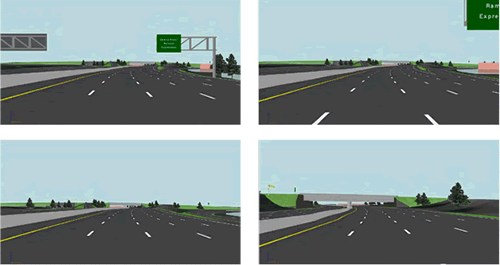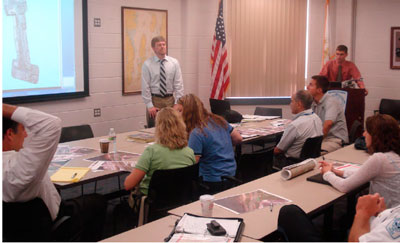Purpose
The purpose of this document is to help Federal, State, Tribal, and local (such as municipal and county) agencies understand the benefits of utilizing interactive three- dimensional (3-D) visualization to assist an RSA team in assessing the safety effects of potential roadway designs.
The Federal Highway Administration defines 3-D visualization - also known as design visualization (DV) - as the simulated representation of a design concept and its contextual impacts or improvements.
Innovative technologies and methods, such as those presented in this document, are supported by the Federal transportation bill, Moving Ahead for Progress in the 21st Century Act (MAP-21). Section 1304 of the bill specifically addresses the use of innovative technologies and states that it is, "in the national interest to promote the use of innovative technologies and practices that increase the efficiency of construction of, improve the safety of, and extend the service life of highways and bridges."(1) An example of an innovative technology includes the use of 3-D visualization technologies.
Section 1503 states that transportation projects that receive Federal funding are encouraged to use advanced visualization technologies during environmental, planning, financial management, design, simulation, and construction process. These advanced visualization technologies include 3-D modeling that can enhance the detail and accuracy of project designs, increase safety, accelerate construction and reduce construction costs, or otherwise expedite project delivery with respect to transportation projects that receive Federal funding.
FHWA further supports the use of 3-D modeling through the second Every Day Counts (EDC-2) initiative and the second Strategic Highway Research Program (SHRP 2). EDC-2 initiatives are aimed at the use of new technologies and innovative processes that can shorten the completion time of highway projects and a 2012 initiative included the use of 3-D modeling.(2) The goal of the SHRP 2 program is to research methods of expediting highway work with minimal disruption to the community.(3)

Figure 2: Three-dimensional visualization enables an RSA team to drive through a project in the design stage
3-D Visualization Overview
There were three primary goals for the four RSAs conducted for this project:
- To evaluate whether existing issues contributing to crashes were addressed through proposed designs.
- To identify design elements that may be modified or included to further enhance safety.
- To address potential safety concerns associated with existing alignments beyond the proposed design projects.
To aid in achieving these goals, the RSA team utilized 3-D visualization techniques to model the proposed designs (see Figure 2).
Three-dimensional models of the proposed concepts and designs were developed using digital terrain models, design surface models, associated 2-D or 3-D computer-aided design (CAD) files, and other information necessary to create a detailed rendering of the proposed roadway and surrounding environment. This included traffic control signs, pavement markings, lane configurations, major landscaping, roadside appurtenances, traffic signals, and other relevant items within the right-of-way to render a realistic view of the roadway. The model was created in PDF format so that it could be used by nearly anyone with access to a computer, since Adobe PDF software can be downloaded for free; in other words, team members did not have to purchase specialized design software to view the 3-D models. Furthermore, the controls were easy to use for someone with basic computer skills. The user could easily rotate 360 degrees while "walking" or "driving" through stations spaced 100 feet apart along the proposed alignment. The use of this tool during the RSA allowed team members to visualize the project designs and identify elements that may pose a safety concern to future road users. These elements can then be further discussed and evaluated during design phases, allowing changes to be more easily made to plans rather than after the roadway has been constructed. The methodology used for creating the 3-D models utilized in this effort is described in Appendix B.
The 3-D model was reviewed by the RSA team during the start-up meeting (Step 3 in the RSA process) and during the RSA analysis workshop (Step 5 in the RSA process). During the start-up meeting, one person familiar with navigating the controls of the 3-D model virtually "drove" through the project and pointed out some basic design features and area landmarks to familiarize the RSA team with the design. Later, during the RSA analysis workshop, a more detailed virtual "drive-through" was conducted using the model (see Figure 3). The objective of this review was to more thoroughly analyze and discuss the various aspects of the design.

Figure 3: RSA team reviewing a 3-D model
These RSA projects for this effort are summarized in Table 2; detailed information about each RSA project is included in Appendix A.
Table 2 : Pre-construction stage RSAs conducted using 3-D visualization
| Location and Host Agencies | Design Stage | Facility Type | Focus |
|---|---|---|---|
| Middletown, RI; Rhode Island Department of Transportation (RIDOT), Aquidneck Island Planning Commission, US Navy | Preliminary Concept (0 - 1%) |
Two-lane limited access connector road |
New roadway concept and potential alternative intersection designs. |
| Belgrade, MT; Montana Department of Transportation (MDT) |
Conceptual (1 - 25%) |
Expressway interchanges |
New Interstate highway access. |
| Prince William County, VA; Prince William County Department of Transportation, Virginia Department of Transportation (VDOT) | Advanced (90%) |
Two-lane road widened to four lanes |
Roadway widening and curve flattening and realignment. |
| Perris, CA; Riverside County Transportation Commission (RCTC), California Department of Transportation (Caltrans) | Preliminary (40 - 80%) |
Expressway interchanges; multilane arterial |
New complex interchange design. |
Three-dimensional visualization should not be confused with microsimulation or advanced computer traffic simulation techniques that are performed by traffic microsimulation programs, such as Synchro, CORSIM, or VISSIM. Microsimulation is used to assess the impact of traffic flow and determine vehicular delay results. These programs also enable the user to visualize traffic operations on the roadway network but are not designed for detailed assessments of designs.
